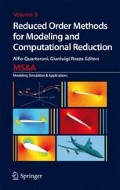Abstract
We propose a modified parallel-in-time — parareal — multi-level time integration method that, in contrast to previously proposed methods, employs a coarse solver based on a reduced model, built from the information obtained from the fine solver at each iteration. This approach is demonstrated to offer two substantial advantages: it accelerates convergence of the original parareal method for similar problems and the reduced basis stabilizes the parareal method for purely advective problems where instabilities are known to arise. When combined with empirical interpolation methods (EIM), we develop this approach to solve both linear and nonlinear problems and highlight the minimal changes required to utilize this algorithm to accelerate existing implementations. We illustrate the advantages through algorithmic design, through analysis of stability, convergence, and computational complexity, and through several numerical examples.
Access this chapter
Tax calculation will be finalised at checkout
Purchases are for personal use only
References
Ascher, U.M., Ruuth, S.J., Wetton, B.T.R.: Implicit-explicit methods for time-dependent partial differential equations. SIAM J. Numer. Anal. 32(3), 797–823 (1995)
Baffico, L., Bernard, S., Maday, Y., Turinici, G., Zérah, G.: Parallel-in-time moleculardynamics simulations. Physical Review E 66(5) (2002)
Bal, G.: On the Convergence and the Stability of the Parareal Algorithm to Solve Partial Differential Equations. In: Domain decomposition methods in science and engineering, pp. 425–432. Lecture Notes in Computational Science and Engineering, Vol. 40. Springer-Verlag, Berlin Heidelberg (2005)
Barrault, D., Maday, Y., Nguyen, N., Patera, A.: An empirical interpolation method: application to efficient reduced-basis discretization of partial differential equations. Comptes Rendus Mathematique 339(9), 667 (2004)
Cavar, D., Meyer, K.E.: LES of turbulent jet in cross flow: Part 2 POD analysis and identification of coherent structures. Inter. J. Heat Fluid Flow 36, 35–46 (2012)
Chatterjee, A.: An introduction to the proper orthogonal decomposition. Current Science-Bangalore 78(7), 808 (2000)
Chaturantabut, S., Sorensen, D.: Nonlinear model reduction via discrete empirical interpolation. SIAM Journal on Scientific Computing 32(5), 2737 (2010)
Dai, X., Maday, Y.: Stable parareal in time method for first and second order hyperbolic system. arXiv preprint arXiv:1201.1064 (2012)
Emmerich, E.: Discrete versions of Gronwall’s lemma and their application to the numerical analysis of parabolic problems, 1st ed.. TU, Fachbereich 3, Berlin (1999)
Farhat, C.: Cortial, J.: Dastillung, C., Bavestrello, H.: Time-parallel implicit integrators for the near-real-time prediction of linear structural dynamic responses.. International journal for numerical methods in engineering 67(5), 697 (2006)
Gander, M., Petcu, M.: in ESAIM: Analysis of a Krylov subspace enhanced parareal algorithm for linear problems. Proceedings, vol. 25, pp. 114–129 (2008)
Gander, M., Vandewalle, S.: Analysis of the parareal time-parallel time-integration method. SIAM Journal on Scientific Computing 29(2), 556 (2007)
He, L.: The reduced basis technique as a coarse solver for parareal in time simulations. J. Comput. Math 28, 676 (2010)
Hesthaven, J.S., Gottlieb, S., Gottlieb, D.: Spectral Methods for Time-Dependent Problems. Cambridge University Press, Cambridge, UK (2007)
Hesthaven, J.S., Warburton, T.: Nodal Discontinuous Galerkin Methods: Algorithms, Analysis, and Applications. Springer-Verlag, New York (2008)
Lions, J., Maday, Y., Turinici, G.: A “parareal” in time discretization of pde’s. Comptes Rendus de l’Academie des Sciences Series I Mathematics 332(7), 661 (2001)
Maday, Y., Turinici, G.: Parallel in time algorithms for quantum control: Parareal time discretization scheme. International journal of quantum chemistry 93(3), 223 (2003)
Maday, Y.: Parareal in time algorithm for kinetic systems based on model reduction. High-dimensional partial differential equations in science and engineering 41, 183
Nielsen, A.S.: Feasibility study of the parareal algorithm. MSc thesis, Technical University of Denmark (2012)
Rozza, G., Huynh, D., Patera, A.T.: Reduced basis approximation and a posteriori error estimation for affinely parametrized elliptic coercive partial differential equations. Archives of Computational Methods in Engineering 15(3), 229 (2008)
Ruprecht, D., Krause, R.: Explicit parallel-in-time integration of a linear acousticadvection system. Computers & Fluids 59, 72 (2012)
Staff, G.; Rønquist, E.: Stability of the parareal algorithm. Domain decomposition methods in science and engineering pp. 449–456 (2005)
Skvortsov, L.M.: Diagonally implicit Runge-Kutta methods for stiff problems. Computational Mathematics and Mathematical Physics 46(12), 2110 (2006). DOI 10.1134/S0965542506120098. http://www.springerlink.com/index/10.1134/S0965542506120098
Verlet, L.: Computer “experiments” on classical fluids. i. thermodynamical properties of lennard-jones molecules. Physical review 159(1), 98 (1967)
Xu, Y., Shu, C.: Local discontinuous galerkin methods for the Kuramoto-Sivashinsky equations and the Ito-type coupled KdV equations. Comp. Methods Appl. Mech. Engin. 195(25), 3430–3447 (2006)
Yan, J., Shu, C.: A local discontinuous Galerkin method for KdV type equations. SIAM J. Num. Anal. 40(2), 769–791 (2002)
Author information
Authors and Affiliations
Corresponding author
Editor information
Editors and Affiliations
Rights and permissions
Copyright information
© 2014 Springer International Publishing Switzerland
About this chapter
Cite this chapter
Chen, F., Hesthaven, J.S., Zhu, X. (2014). On the Use of Reduced Basis Methods to Accelerate and Stabilize the Parareal Method. In: Quarteroni, A., Rozza, G. (eds) Reduced Order Methods for Modeling and Computational Reduction. MS&A - Modeling, Simulation and Applications, vol 9. Springer, Cham. https://doi.org/10.1007/978-3-319-02090-7_7
Download citation
DOI: https://doi.org/10.1007/978-3-319-02090-7_7
Publisher Name: Springer, Cham
Print ISBN: 978-3-319-02089-1
Online ISBN: 978-3-319-02090-7
eBook Packages: Mathematics and StatisticsMathematics and Statistics (R0)

